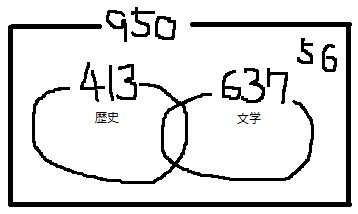〔カモメ高校の授業公開にやってきたダイキと、アメリカの中学生であるオリビア。
カモメ高校の生徒であるミクとカイトウが彼らを案内する(リード文は全て英文)〕
◆(ア)
本文中の( ① )に入れるのに最も適するものを選びなさい。
―本文抜粋―
Daiki;I’ve heard that many Kamome High School students study hard
and practice hard in some classes.
Olivia;Really? I didn’t know that. Then ( ① ).
Kaito;Sure.
Olivia;How many students are in clubs now?
1:do you have any questions? 2:how many questions can I ask?
3:may I ask you a question? 4:will you ask me a question?
3
*和訳。
ダイキ;多くのカモメ高校の生徒は勉強に熱心で、部活動も懸命に励んでいると聞きました。
オリビア;本当?それは知らなかったわ。それでしたら、( ① )。
カイトウ;どうぞ。
オリビア;今、どれくらいの生徒が部活動をしているのですか?
案内役のカイトウたちにオリビアが質問をする。
どの選択肢にもquestionが含まれているので紛らわしい。
1:質問はありますか? 2:どのくらい質問してもよろしいでしょうか?
3:質問してもよろしいでしょうか? 4:私に質問してくれませんか?
◆(イ)
本文中の②~④に入る数字を答えなさい。
―本文抜粋―
Olivia;How many students are in clubs now?
Kaito;There are 950 students at Kamome High School now and 94% of them join the clubs.
Miku;*Actually, 575 students play sports as members of the *sports teams like soccer,
basketball, and tennis, and 358 students are in *cultural clubs like art, music, and science.
Olivia;So 933 students are in clubs in this school.
Daiki;Well, 94% of 950 students is not 933 but ( ② ) students.
Olivia;Oh, you’re right. It’s not 933. Why are the numbers of the students different?
Kaito;They are different because some students are the members of both a sports team
and a cultural clubs. But there are no students who join two or more sports teams
and no students who join two or more cultural clubs.
Only ( ③ ) students *don’t join either a sports team or a cltural club.
Daiki;Now I see. ( ④ ) students are in both a sports team and a cultural club.
*Actually・・実際には sports team・・運動部 cultural club・・文化部
don’t ~ either a sports team or a cultural club・・運動部も文化部もどちらも~ない
②―893 ③―57 ④―40
*和訳。
オリビア;今、どのくらいの生徒が部活動をしているのですか?
カイトウ;現在、カモメ高校には950名の生徒が在籍しており、
そのうち94%の生徒が部活動に参加しています。
ミク;実際には、575名の生徒がサッカーや、バスケ、テニスといった運動部の部員であり、
358名が芸術や音楽、科学といった文化部に所属していますよ。
オリビア;ということは、933名の生徒がカモメ高校で部活動をしているのですね。
ダイキ;うーん、950の94%は933ではなくて、( ② )の生徒だね。
オリビア;あぁ、、その通りですね。933じゃないわ。どうして生徒の数が違っちゃうのかしら?
カイトウ;運動部と文化部の両方に所属する生徒がいくらかいるから違くなるのさ。
どの生徒も複数の運動部に所属していない、複数の文化部にも所属していない。
( ③ )の生徒だけが、運動部にも文化部にも参加していないよ。
ダイキ:なるほど。( ④ )の生徒が運動部にも文化部にも所属していることになるのか。
*ちなみに、『cultural club』というとネイティブは”どこかの国や民族の文化を研究するクラブ”と
誤解するそうです。非運動部という意味では、non-athletic clubもしくはacademic clubが無難。
ベン図問題。
②:950の94%を答えるだけ。950×94%=893

2つの○の和から重なりをひいた部分(横に倒したヒョウタン)が893となる。
③:運動部にも文化部に所属していない人。
ヒョウタンの外側にいる人は・・950-893=57
④:運動部・文化部ともに所属している人はヒョウタンの真ん中、2つの円の重なり。
2つの円の合計からヒョウタンをひけば重なりがでる。
575+358-893=40
◆(ウ)
英文の接続詞を空欄補充する設問。~省略~
◆(エ)
⑦に入る数字を答えなさい。
―本文抜粋―
Miku;Look at *Table. This is the data about the books here
and the number of the students who borrowed the books last month.

Daiki;When we look at the data for history and literature, a lot of students borrowed these books.
The number of the students who borrowed them is over 950.
There *must be some students who borrowed both kinds of books.
Miku;Yes. You’re right.
Daiki;Are there any students who borrowed *neither of them?
Miku;Yes. Actually, there are 56 students. They *didn’t borrow either of these books.
Olivia;Then the number of the students who borrowed both kinds of books must be…
Daiki;It must be ( ⑦ ).
Kaito;That’s right.
*Table・・表 must・・~はずだ
neither of~・・~のどちらもない didn’t either of~・・~のどちらもなかった
156
*和訳。
ミク;表をみてごらん。これはここの本と、先月本を借りた生徒の人数に関するデータです。
ダイキ;歴史と文学のデータをみると、たくさんの生徒がこれらの本を借りていますね。
これらの本を借りた生徒の数は950を超えています。どちらも借りた生徒もいたはずです。
ミク;そう。その通りよ。
ダイキ;どちらも借りなかった生徒もいますよね。
ミク;ええ。実際に、どちらも借りなかったのは56人だったわ。
オリビア;じゃあ、両方とも借りた生徒の数は・・・。
ダイキ;( ⑦ )のはずだ!
カイトウ;その通り!
ベン図問題2。
全校生徒は前問から950名。
表から歴史は413、文学は637名借りて、どちらも借りていないのは56名。

950-56=894(横に倒したヒョウタン)
413+637=1050(2つの円の和)
2つの円の和からヒョウタンをひけば重なりの部分、
すなわち、両方を借りた人は1050-894=156名
◆(オ)
四つ折り判(quarto)の本をすべて同じ向きにすき間なく並べて、
できるだけ小さい正方形になるように展示する場合、
全部で何冊並べることができるか答えなさい。
―本文抜粋―
Miku;These are the books made in foreign countries. This size is called *quato.
In Japan, we usually use A4, but in other countries, people use quarto, too.
A4 is 21 *centimeters *wide and 29.7 centimeters high.
Quarto is 24 centimeters wide and 30 centimeters high.
*quarto・・四つ折り判 centimeters・・センチメートル wide・・幅
20冊
*和訳。
これらは海外で作られた本です。このサイズは四つ折り判といわれています。
日本では普通、A4サイズが使われていますが、海外では四つ折り判も使うのよ。
A4は横21cm、縦29.7cm、四つ折り判は横24cm、横30cmね。
計算は基本問題。
24と30の最大公約数は6。
横に5冊、縦に4冊並べれば、120cmの正方形が出来上がり。
5×4=20冊
◆(カ)
本文の空欄補充。 ~省略~
◆(キ)
カモメ高校の校舎を模式図として表したとき、最も適するものを選びなさい。
―本文抜粋―
Miku;Now we are on the second floor.(library)
Look at the map. The music room is on the sixth floor.
There are some classrooms between each *staircase.
Six classrooms are on the second and third floors,
but there are only four on the fourth and fifth floors.
staircase・・階段

3
*和訳。
今、私たちは二階にいるわ。地図を見て。
音楽室は6階にあって、各階段のあいだいに教室があるわ。
6つの教室が2階と3階にあるけど、4階と5階には4つしかないわ。
正解率は高いので、間違えられない。
◆(ク)
ある場所から他の場所への最短経路(遠回りしない)について考える。
図のように、大きさの等しい6個の立方体からなる立体があり、
立方体のすべての辺(立体の内部にある部分を含む)を通ることができるものとする。
例えば、点Aから点Cまでの最短経路は6通りある。
このとき、点Aから点Bまでの最短経路のうち、
点Dと点Eをいずれも通らないものは何通りあるか答えなさい。

20通り
*最短経路の求め方。
いろいろあるが、本問は↓が便利。

出発点Aから横と縦に1を書く。
あとは斜めで足していく。
反対側の頂点までの最短経路は4通りある。

Bの真下をFとする。
DとEを通らないので、F⇒Bしかない。
Fまでの最短経路を求める。
Fの下は、先ほどの求め方で4通り(立体の底面積で考える)
Fの左も、同じく4通り(奥の側面席で考える)
Fの手前をGとする。
Gの下と左は、同じやり方でともに3通り。
Cは問題文から6通り。
以上から、4+4+3+3+6=20通り
◆(ケ)
本文の内容正誤。8択から3つ選ぶ。~省略~
難問特色検査の解説ページに戻る



コメント